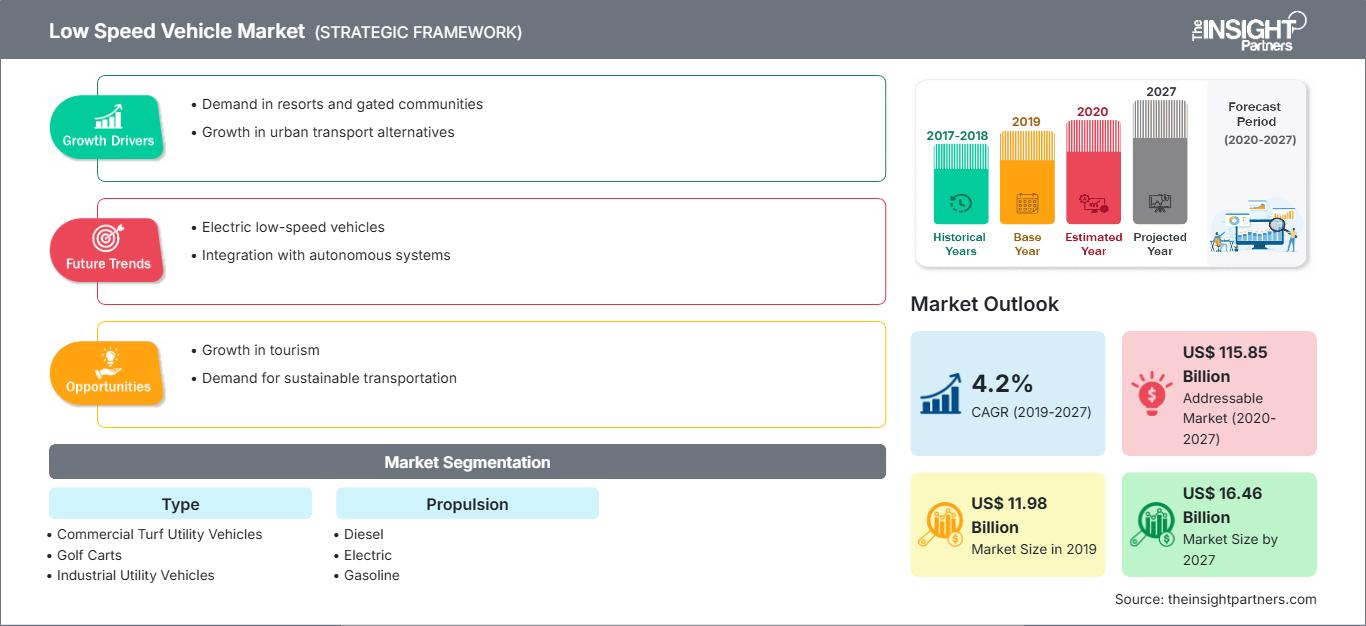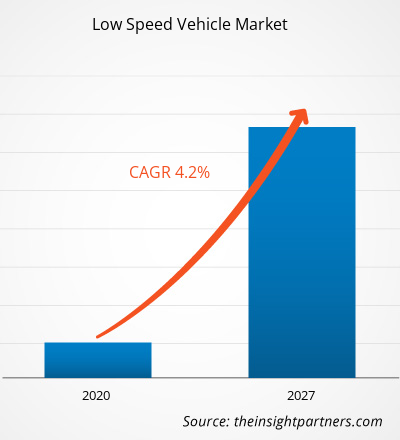2019 年低速汽车市场价值为 119.8 亿美元,预计 2020 年至 2027 年的复合年增长率为 4.2%,到 2027 年将达到 164.6 亿美元。
过去几年,全球低速汽车市场增长显著。积极的经济前景、不断增长的可支配收入和不断增长的人口是推动基础设施项目需求的因素之一。此外,由于在线订单量大,电子商务行业正在增长,这将导致该地区的仓库所有权增加。仓库内的低速汽车支持将箱子从一个地方转移到另一个地方。上述因素在加速低速汽车市场增长方面发挥着重要作用。亚太地区在 2019 年占据最大市场份额,预计将成为低速汽车市场增长最快的地区。北美和欧洲分别是低速汽车市场的第二大和第三大地区。
2019年12月,新冠病毒疫情在中国武汉爆发。疫情迅速蔓延至全球,受影响最严重的国家包括中国、意大利、伊朗、西班牙、韩国、法国、德国和美国。新冠疫情的爆发及其导致的边境封锁、停工、旅行禁令等影响已开始影响各行各业。由于全球供应链中断,预计低速汽车市场将受到中等程度的影响。短期内(3-6个月),低速汽车市场的整体销售额将有所下降,但未来几年市场将稳步增长。
自定义此报告以满足您的要求
您将免费获得任何报告的定制,包括本报告的部分内容,或国家级分析、Excel 数据包,以及为初创企业和大学提供超值优惠和折扣
低速汽车市场: 战略洞察

-
获取本报告的主要市场趋势。这个免费样本将包括数据分析,从市场趋势到估计和预测。
欧盟、中国、日本、加拿大、印度和韩国等主要地区的政府都在积极采取措施,推动电动汽车的普及。例如,欧盟在现有车辆的燃油经济性标准方面取得了显著进步。欧盟制定了《清洁汽车指令》,要求政府部门采购电动公交车。此外,欧盟还制定了《建筑能效指令》,为在建筑物内设置充电基础设施设定了最低标准。
推进系统洞察
低速汽车市场按推进系统可分为柴油、电动和汽油。燃料驱动的汽车在全球低速汽车市场中占据主导地位。能够在允许道路上行驶并可用作多用途车辆和人员运输车的大功率汽车日益增多。因此,在预测期内,电动低速车辆预计将实现显著增长,同时高功率低速车辆也有望最终推动低速车辆市场的发展。
类型洞察
低速车辆市场按类型细分为商用草坪多用途车、高尔夫球车、工业多用途车和人员运输车。高尔夫球车在全球低速车辆市场中占据主导地位。美国一些社区严重依赖低速电动汽车出行。对于老年人来说,步行有时会很困难,而开车则会很累,甚至不安全。
公司通常采用市场主动性和新的发展战略来扩大其全球影响力并满足不断增长的需求。这些战略主要在北美和欧洲实施。低速车辆市场的参与者采用扩张和投资研发的战略,以扩大全球客户群,这也使得参与者能够在全球范围内维护其品牌名称。
低速车辆市场区域洞察
The Insight Partners 的分析师已详尽阐述了预测期内影响低速汽车市场的区域趋势和因素。本节还讨论了北美、欧洲、亚太地区、中东和非洲以及南美和中美洲的低速汽车市场细分和地域分布。
低速汽车市场报告范围
| 报告属性 | 细节 |
|---|---|
| 市场规模 2019 | US$ 11.98 Billion |
| 市场规模 2027 | US$ 16.46 Billion |
| 全球复合年增长率 (2019 - 2027) | 4.2% |
| 历史数据 | 2017-2018 |
| 预测期 | 2020-2027 |
| 涵盖的领域 |
By 类型
|
| 覆盖地区和国家 |
北美
|
| 市场领导者和主要公司简介 |
|
低速汽车市场参与者密度:了解其对业务动态的影响
低速汽车市场正在快速增长,这得益于终端用户需求的不断增长,而这些需求的驱动因素包括消费者偏好的不断变化、技术进步以及对产品优势的认知度不断提高。随着需求的增长,企业正在扩展产品线,不断创新以满足消费者需求,并抓住新兴趋势,从而进一步推动市场增长。

- 获取 低速汽车市场 主要参与者概述
- 商用草坪多用途车
- 高尔夫球车
- 工业多用途车
- 人员运输车
低速车辆市场 - 按推进力
- 柴油
- 电动
- 汽油
低速车辆市场 - 按类型
- 柴油
- 电动
- 汽油
低速车辆市场 -
- 按地理位置
-
北美洲
- 美国
- 加拿大
- 墨西哥
-
欧洲
- 法国
- 德国
- 意大利
- 英国
- 俄罗斯
- 欧洲其他地区
-
亚太地区
- 中国
- 印度
- 澳大利亚
- 韩国
- 日本
- 亚太其他地区
-
中东和非洲
- 南非
- 沙特阿拉伯
- 阿联酋
- 中东和非洲其他地区
-
南美洲
- 巴西
- 阿根廷
- 南美洲其他地区
公司简介
- Bintelli 电动车
- Club Car, LLC
- Cruise Car, Inc.,
- Deere & Company
- HDK Co., Ltd.
- Moto 电动车
- Polaris Inc.
- Textron Specialized Vehicles Inc.
- The Toro Company
- Yamaha Golf-Car Company
- 历史分析(2 年)、基准年、预测(7 年)及复合年增长率
- PEST和SWOT分析
- 市场规模、价值/数量 - 全球、区域、国家
- 行业和竞争格局
- Excel 数据集
近期报告
相关报告
客户评价
购买理由
- 明智的决策
- 了解市场动态
- 竞争分析
- 客户洞察
- 市场预测
- 风险规避
- 战略规划
- 投资论证
- 识别新兴市场
- 优化营销策略
- 提升运营效率
- 顺应监管趋势






















 获取免费样品 - 低速汽车市场
获取免费样品 - 低速汽车市场